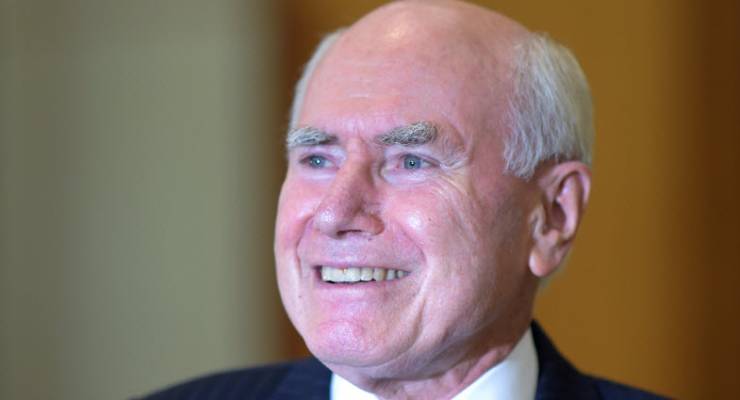
John Howard and Philip Ruddock have been the unwelcome, but ever present, guests at the weddings of many Australians since 2004. For the majority of Australian couples getting married today, there’s a part of the ceremony that has existed since 2004 that many now find archaic.
Much of the plebiscite debate — if the almost-doomed legislation actually passes — will focus on so-called religious freedom that is under threat because their understanding of marriage isn’t the only one legal anymore. It will not just be about Christian bakers forced to bake big gay wedding cakes (the horror!), or florists who have somehow managed to avoid being around gay people their entire lives suddenly horrified to discover gays might like to buy flowers, but also marriage celebrants who aren’t part of a religious organisation who may object to same-sex marriage.
Attorney-General George Brandis told LGBTI advocates on a group call Thursday night celebrants would be able to be “conscientious objection” and refuse to perform same-sex weddings. This goes beyond the Labor and cross-party bills, which only provide exemptions for religious ministers from providing wedding services for same-sex couples.
This — yet another sop to the right — appears to be completely unwarranted, however. You only need to look at the recent history of changes to the Marriage Act to realise no such conscientious objector exemptions have ever been granted in the past. Quite the opposite, in fact.
[Essential: if plebiscite is blocked, voters want Parliament to pass marriage equality]
In 2004, when the Coalition and Labor teamed up to ban same-sex marriage, Section 46 was inserted into the Marriage Act. This section requires celebrants — but not ministers of religion — to say the following words exactly:
“I am duly authorised by law to solemnise marriages according to law.
“Before you are joined in marriage in my presence and in the presence of these witnesses, I am to remind you of the solemn and binding nature of the relationship into which you are now about to enter.
“Marriage, according to law in Australia, is the union of a man and a woman to the exclusion of all others, voluntarily entered into for life.”
Marriage celebrants since 2004 have been required to read out this line at every wedding, while ministers of religion have an exemption on the grounds that the ceremony “sufficiently states the nature and obligations of marriage” as you’d expect they do. According to the ABS, this means that it is read out at a majority of the ceremonies in Australia, with 2014 stats showing 74.1% of marriages being performed in Australia by civil celebrants.
Celebrants often apologise to couples for having to read out these lines in the ceremony, and often couples request to include statements after this to acknowledge that they hope for the law to be changed some day.
Celebrants themselves, however, do not get an option to object. Failure to comply with this section of the act could get a celebrant disciplined or ultimately deregistered. If this was something they had issue about with their own religious beliefs, we would not hear the end of it, but celebrants today who believe same-sex marriage should be made law are left to read out this archaic text John Howard’s government has inserted into every secular marriage ceremony since 2004.
[Seven things we could use $15m for instead of funding plebiscite arguments]
But the celebrants haven’t revolted.
Keith Lammond from Australian Marriage Celebrants said that the most that would usually happen would be a warning or additional classes.
“The Attorney General’s Department takes a very dim view if a celebrant is caught omitting this statement to the parties,” he said.
But Lammond said that while some couples might request it be removed to avoid offending their gay friends, it was unlikely many celebrants were actively trying to challenge the 2004 Howard amendment in their ceremonies.
“Celebrants are appointed under the Marriage Act and are expected to perform their responsibilities accordingly. If the world changes in Australia, then we will all work according to the new act. We will always strive to do our best for our clients, providing it is within the law.”
Someone recently filed a freedom of information request on the statistics of celebrant registrations and deregistrations. The stats show there were more than 2645 deregistrations in total in 2014, compared to 703 registrations. Most of these were for retirement or resignation, but 721 were for disciplinary measures. Crikey asked the Attorney-General’s Department whether any of this fell under failing to comply with section 46 of the act, but the department said it doesn’t collect that sort of data.








Why can’t parliament just scrap section 46 of the act the same way that they introduced it?
We should be debating economic reforms, job creation and such. Too much time spent on this essential meaningless legislation that effect an even smaller amount of people.
It affects millions of people and makes Australia look like a bunch of red necks. If you don’t think that impacts our economy, you should get out more.
The LNP doesn’t have any policies for the future so they are busy reasserting their competence in bronze-age theology.
If some of these conscientious objectors were whistle-blowers against real moral and ethical transgressions then this same government would enthusiastically prosecute them.
John Howard inserting his archaic comments into all of the marriages is sacrilege to any idea of HUMAN RIGHTS! The original marriage Act only stated that marriage is between “a couple”. It did not say it had to be a man and a woman at all. If Scotland, Ireland, Canada and even New Zealand have marriage equality than surely it is time for Australia to grow up?? http://www.justcounsel.co/the-common-law-wife-1-a-very-short-history-of-marriage-in-england-wales/